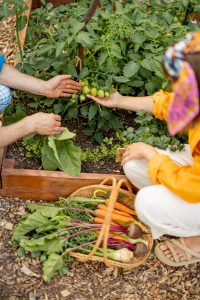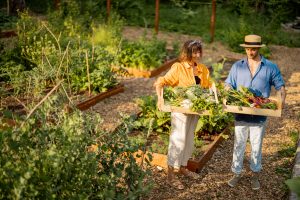A vegetable and herb garden is an exciting and productive way to grow fresh ingredients at home. Green Nest News believes it allows you to access healthy, freshly picked produce from the comfort of your backyard, balcony, or rooftop.
Cutting food expenses, eliminating grocery shopping, enhancing flavors in meals, and bonding with nature saves money over time.
Benefits of Growing Your Garden
Taking care of your vegetable garden could boost your mental health. You get a peaceful space away from day-to-day tensions and the fulfillment of growing something extra special. To top it off, when you are growing your fruits and vegetables, you are most likely to eat them. This can be a great cost-saver at the grocery stores.
Save Money on Groceries
 You will be saving money by growing your vegetables and herbs because organic produce prices have gone up above 25% in late 2021. At least planting tomatoes, cucumbers, or organic carrots will cost you only around $3 for a season.
You will be saving money by growing your vegetables and herbs because organic produce prices have gone up above 25% in late 2021. At least planting tomatoes, cucumbers, or organic carrots will cost you only around $3 for a season.
A well-planned garden can help reduce food waste, such as letting you pick only what you need. It all starts with evaluating the sunlight, soil, and water of your yard or patio and designing the garden to fit it.
You can achieve spectacular outcomes if you ever carefully plan with small spaces.
Enjoy Fresh and Organic Produce
Homegrown vegetables and herbs taste better and are healthier than store-bought ones, which can be weeks old. Fresh produce from your garden is nutritious, affordable, and often organic.
By selecting crops that suit your climate and using compost, you can increase your yield. Growing staples like basil, parsley, and tomatoes enhance flavor and reduce pesticide use. Companion planting, such as pairing tomatoes with basil, boosts growth and saves space.
Promote a Sustainable Lifestyle
One way of using your garden to promote a green lifestyle is by providing fewer food miles. For instance, most grocery stores throw away packaging; however, it would be otherwise with a homemade garden.
Gardening techniques are many, which suit small patios. An urban gardener finds attractive ones like galvanized tubs useful. This again minimizes the carbon footprint associated with store-purchased produce.
Enhance Mental and Physical Well-Being
For your health, keeping active, and combating stress, use a salad garden with lettuce or arugula to encourage proper eating habits or an herb garden with thyme or oregano to intensify flavors with meals.
Grown in pots, salsa gardens with tomatoes, cilantro, and peppers make for creative cuisine, and while marinara gardens are grown along window sills, nurturing plants can assist someone’s mental state and provide accomplishment.
Choosing the Right Location
Selecting the right place to plant vegetables and herbs requires common sense that determines crop growth and harvest success.
By taking into account sunlight, soil nutrients, water availability, and design, many gardeners can prepare for a healthy and productive space.
Assess Sunlight Availability
Vegetables and herbs need at least six hours of direct sunlight per day. Therefore, select a sunny location. Southern exposure is suitable for sun-loving plants such as tomatoes and peppers. Strong afternoon light is useful for varieties that can tolerate the heat.
Be aware, however, that some parts of your yard receive very little sun, wind, and less heat than other parts. Mornings are soft compared to the strength the sun brings during the afternoons; thus, so much understanding will make a healthy difference in growth.
Evaluate Soil Quality
Good garden soil is the biggest factor determining a good garden. Root vegetables, such as carrots and radishes, prefer loosening soil, so ensure that the soil conditions are fertile and drain well. Instead of using chemical fertilizers that might kill your plants, improve the soil quality with compost or organic fertilizers.
Sometimes, it becomes essential to test the pH and nutrient levels in the soil to make sure that your plants are healthy. Mulching maintains moisture and regulates temperature, thus aiding in growth.
Consider Water Access
A healthy garden requires an adequate supply of water. Select a location near a hose or rain barrel for easy access to water.
Leafy greens, such as lettuce and spinach, like consistent moisture while herbs like basil and mint prefer less moisture. Drip irrigation systems and soaker hoses make watering easier and avoid overwatering, but give just the right amount.
Plan for Space and Layout
A garden is all about planning. Make the most of space-saving plants, like tomatoes and cucumbers, using the support of trellises.
Plant herbs in pots to avoid a lot of growth space. Plant by sun requirements: put the tallest plants where they won’t shade out the smaller ones. Plan your pathways so it is easy to prune, weed, and harvest your garden without a mess.
How to Start a Vegetable and Herb Garden
Choose the sunniest spot in your yard to begin your vegetable and herb garden. Add compost to the soil to provide nutrients. Start with easy crops such as tomatoes, basil, and lettuce. Make sure you have the right tools and knowledge to care for your plants as they grow!
1. Select Vegetables and Herbs to Grow
 Choose the vegetables and herbs that your family will enjoy. Tomatoes, bell peppers, lettuce, and basil are popular choices.
Choose the vegetables and herbs that your family will enjoy. Tomatoes, bell peppers, lettuce, and basil are popular choices.
For new gardeners, consider some of the easier herbs, such as mint, parsley, and chives, for a feeling of accomplishment.
Most vegetables require at least 6-8 hours of direct sunlight per day, so this will be part of your considerations when planning.
2. Prepare the Soil for Planting
Healthy soil is the lifeblood of a healthy garden. Organic compost or aged manure will help improve an in-ground garden.
For smaller or urban gardens, raised beds are perfect, using approximately 8 cubic feet of quality soil per 6-inch bed. Kits for soil testing check acidity and vegetables and herbs require a pH between 6.0 and 7.5 to grow at their best.
3. Choose the Right Gardening Tools
The right tools will make gardening even more enjoyable. Tools needed are the trowel, gloves, pruners, a hand rake, and a hose with an adjustable nozzle. A spade or a wheelbarrow would be helpful for areas covering larger spaces. Use lightweight tools that are easier to use. This is true for beginners, also.
4. Plan a Simple Garden Layout
A well-planned garden layout increases yield while saving time and energy. Begin with a 10×10-foot plot and use intensive cropping by planting two or three compatible plants in a 4-foot-wide bed. Make sure pathways are accessible for wheelchairs or walkers, and group plants that have similar sun and water needs.
5. Start Planting Step by Step
Plant seeds at the depth and spacing specified by the packet. For rapidly growing vegetables such as carrots and radishes, sow seeds directly into the soil; for slower growers like tomatoes, obtain starter plants from a local nursery. Keeping rows straight will make maintenance and harvest easier to manage.
6. Water and Mulch Properly
Most vegetables require about 1 inch of water per week. Water them uniformly with a soaker hose or watering can. Mulch helps retain moisture and prevent weeds; use at least 2 inches of organic mulch such as straw, wood chips, or shredded leaves.
7. Monitor Growth and Address Issues
Watch your vegetables for pests or diseases, and also for nutrient deficiencies. Yellow leaves suggest overwatering or a possible lack of nitrogen. Weeds will steal all the food from your vegetables; weed them quickly as they appear. For herbs, such as basil, pinch the flowers off to encourage a bushier, non-flowering habit.
Harvesting Success: Enjoying the Fruits of Your Vegetable and Herb Garden
The conclusion seems to be that growing a vegetable and herb garden brings new flavors and beauty to your home. It does not take long, some planning, basic tools, and seeds. Creative designs take over small spaces; low-maintenance plants are usually recommended for those with little experience to achieve a good outcome.
Adding personal touches makes your garden feel inviting. There’s cooking improvement through this hobby, stress relief, and even just something fun to have on your hands. Enjoy the process and watch it grow. Contact us for more!


